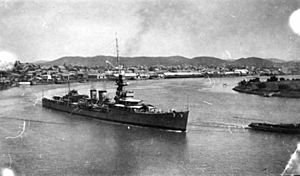HMS Dunedin facts for kids
class="infobox " style="float: right; clear: right; width: 315px; border-spacing: 2px; text-align: left; font-size: 90%;"
| colspan="2" style="text-align: center; font-size: 90%; line-height: 1.5em;" | 
|} HMS Dunedin was a fast, medium-sized warship. It was a light cruiser of the Royal Navy, which is the British navy. The ship was built in England and started serving in 1919. It was named after Dunedin, a city in New Zealand. This city got its name from Edinburgh in Scotland. HMS Dunedin was the only Royal Navy ship ever to have this name.
Contents
- Hunting German Warships
- Operations in the Caribbean Sea
- Capturing Enemy Ships
- Convoy Protection Duty
- The Sinking of HMS Dunedin
| History | |
|---|---|
| Name | HMS Dunedin |
| Builder | Armstrong Whitworth Newcastle-on-Tyne: Hawthorn Leslie and Company, Hebburn |
| Laid down | 5 November 1917 |
| Launched | 19 November 1918 |
| Commissioned | 13 September 1919 |
| Fate | Sunk 24 November 1941 by U-124 |
| General characteristics | |
| Class and type | Danae-class light cruiser |
| Displacement |
|
| Length | 445 ft (136 m) |
| Beam | 46 ft 6 in (14.17 m) |
| Draught | 14 ft 6 in (4.42 m) |
| Propulsion |
|
| Speed | 29 knots (54 km/h) |
| Range | 2,300 nmi (4,300 km) |
| Complement | 462 |
| Armament |
|
| Armour |
|
Service History of HMS Dunedin
HMS Dunedin had an interesting career before and during World War II. It traveled to many parts of the world.
Early Missions and Aid Work
In October 1920, HMS Dunedin helped protect important supplies. These supplies were being unloaded for Poland in a city called Danzig.
Later, in 1931, the ship sailed to Napier, New Zealand. It went there to help after a big earthquake hit the area. HMS Dunedin was part of a group of ships providing aid. Other ships included the Veronica and Diomede.
HMS Dunedin in World War II
When World War II began, HMS Dunedin was quickly put into action. It played a role in several important naval operations.
Hunting German Warships
Early in the war, HMS Dunedin joined the search for two powerful German battleships. These were the Scharnhorst and Gneisenau. This hunt happened after the German ships sank another British vessel, Rawalpindi.
Operations in the Caribbean Sea
In early 1940, HMS Dunedin was working in the Caribbean Sea. Here, it stopped a German merchant ship called Heidelberg. The German crew sank their own ship before Dunedin could capture it.
A few days later, HMS Dunedin teamed up with a Canadian destroyer, Assiniboine. Together, they found and captured another German merchant ship, the Hannover, near Jamaica. The Hannover was later turned into the first British escort carrier, Audacity.
Between July and November 1940, HMS Dunedin and another cruiser, Trinidad, kept a close watch on Martinique. They were making sure three French warships, including the aircraft carrier Béarn, stayed in port.
Capturing Enemy Ships
HMS Dunedin was very successful at capturing enemy vessels. On 15 June 1941, it captured the German tanker Lothringen. This was a very important capture because the tanker was carrying secret Enigma code machines. The Royal Navy later used the Lothringen as an oil supply ship.
Dunedin also captured three ships belonging to Vichy France. These were the Ville de Rouen, the Ville de Tamatave, and the D'Entrecasteaux.
Convoy Protection Duty
On 25 December 1940, HMS Dunedin was helping to protect a group of supply ships called Convoy WS 5A. This convoy was attacked by a German heavy cruiser named Admiral Hipper. Other ships in the convoy's escort fought off the attack. The convoy did not lose any ships.
The Sinking of HMS Dunedin
On 24 November 1941, HMS Dunedin was in the middle of the Atlantic Ocean. It was sailing east of the St. Paul's Rocks, near Recife, Brazil. At 3:26 PM, a German submarine, German submarine U-124, attacked the ship. Two torpedoes hit HMS Dunedin, causing it to sink.
Out of a crew of 486 officers and men, only four officers and 63 men survived. It was a great loss for the Royal Navy.

